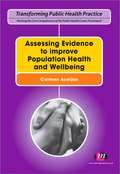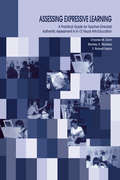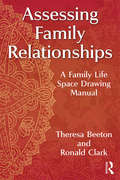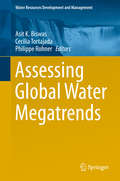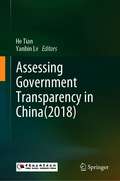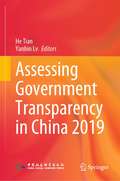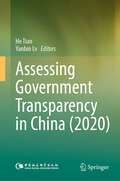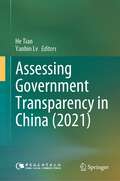- Table View
- List View
Assessing Essential Skills of Veterinary Technology Students
by Laurie J. Buell Lisa E. Schenkel Sabrina Timperman Sandra Lynn Bertholf Amanda ÓnStandardized assessment criteria covering all essential skills from the nine areas required by the American Veterinary Medical Association Committee on Veterinary Technician Education and Activities The newly revised and updated Fourth Edition of Assessing Essential Skills of Veterinary Technology Students provides a comprehensive review of the required American Veterinary Medical Association Committee on Veterinary Technician Education and Activities (AVMA CVTEA®) essential skills for completion of a veterinary technology degree. Each essential skill includes assessment criteria as well as decision-making instructions necessary to demonstrate proficiency both academically and professionally. The text is organized based on the categories provided by the AVMA CVTEA, making it easy for an instructor and students to locate the assessment criteria for a particular essential skill relative to their course. Several guidelines from veterinary organizations regarding standard of care in veterinary medicine have been updated since the publication of the previous edition, including 2018 A AHA Infection Control, Prevention and Biosecurity Guidelines, 2022 AAHA Pain Management Guidelines for Dogs and Cats, 2021 AAHA/AAFP Feline Life Stages Guidelines, 2019 AAHA Canine Life Stages Guidelines, 2021 AAHA Nutrition and Weight Management Guidelines, 2023 AAHA Technician Utilization Guidelines, and others. Written by highly qualified authors, Assessing Essential Skills of Veterinary Technology Students includes assessment criteria that addresses the knowledge, decision-making capabilities, and hands-on skills for the following: Pharmacologic fundamentals of drug administration, pharmacy essentials of drug dispensing, compliance with state and federal regulation, and monitoring of therapeutic responses.Ethics, jurisprudence, and communication in veterinary management.Husbandry, nutrition, and therapeutics of common domestic species, handling and restraint, patient assessment, and dental procedures in small animals.Fundamentals of and experiences with common surgical procedures, patient management and use of anesthetic equipment, proper surgical assistance, pain management, management of surgical equipment and facilities, and perioperative management.Diagnostic laboratory procedures and management of laboratory specimens and equipment, parasitology of common domestic species and diagnostic procedures for parasite, microbiologic procedure and evaluations and necropsy procedures.Avian, exotic, small, and large animal husbandry and nursing skills. The Fourth Edition of Assessing Essential Skills of Veterinary Technology Students is an essential study resource for all undergraduate students enrolled in an AVMA CVTEA accredited veterinary technology program and an excellent teaching resource for instructors of veterinary technology courses.
Assessing Essential Skills of Veterinary Technology Students
by Laurie J. Buell Lisa E. Schenkel Sabrina Timperman Amanda Colón Sandra Lynn BertholfStandardized assessment criteria covering all essential skills from the nine areas required by the American Veterinary Medical Association Committee on Veterinary Technician Education and Activities The newly revised and updated Fourth Edition of Assessing Essential Skills of Veterinary Technology Students provides a comprehensive review of the required American Veterinary Medical Association Committee on Veterinary Technician Education and Activities (AVMA CVTEA®) essential skills for completion of a veterinary technology degree. Each essential skill includes assessment criteria as well as decision-making instructions necessary to demonstrate proficiency both academically and professionally. The text is organized based on the categories provided by the AVMA CVTEA, making it easy for an instructor and students to locate the assessment criteria for a particular essential skill relative to their course. Several guidelines from veterinary organizations regarding standard of care in veterinary medicine have been updated since the publication of the previous edition, including 2018 A AHA Infection Control, Prevention and Biosecurity Guidelines, 2022 AAHA Pain Management Guidelines for Dogs and Cats, 2021 AAHA/AAFP Feline Life Stages Guidelines, 2019 AAHA Canine Life Stages Guidelines, 2021 AAHA Nutrition and Weight Management Guidelines, 2023 AAHA Technician Utilization Guidelines, and others. Written by highly qualified authors, Assessing Essential Skills of Veterinary Technology Students includes assessment criteria that addresses the knowledge, decision-making capabilities, and hands-on skills for the following: Pharmacologic fundamentals of drug administration, pharmacy essentials of drug dispensing, compliance with state and federal regulation, and monitoring of therapeutic responses.Ethics, jurisprudence, and communication in veterinary management.Husbandry, nutrition, and therapeutics of common domestic species, handling and restraint, patient assessment, and dental procedures in small animals.Fundamentals of and experiences with common surgical procedures, patient management and use of anesthetic equipment, proper surgical assistance, pain management, management of surgical equipment and facilities, and perioperative management.Diagnostic laboratory procedures and management of laboratory specimens and equipment, parasitology of common domestic species and diagnostic procedures for parasite, microbiologic procedure and evaluations and necropsy procedures.Avian, exotic, small, and large animal husbandry and nursing skills. The Fourth Edition of Assessing Essential Skills of Veterinary Technology Students is an essential study resource for all undergraduate students enrolled in an AVMA CVTEA accredited veterinary technology program and an excellent teaching resource for instructors of veterinary technology courses.
Assessing EU Leadership in Inter-regional Relations: The Case of the Institutionalisation of ASEAN Disaster Management (Globalisation, Europe, and Multilateralism)
by Giulia TercovichThis book comparatively analyses the role of the EU in influencing the policies of other regional organisations by assessing its role in leading the institutionalisation of ASEAN disaster management institutions. By exploring the role of actors as drivers of the process that led to the institutionalisation of the ASEAN disaster response mechanism, it unpacks the process and assesses the role of the EU in directly or indirectly leading this process, whilst including the role played by other relevant actors, namely Australia, New Zealand, Japan, USA and the UN. In doing so, the book proposes an original framework going beyond the idea of the EU as a sui generis actor and adds a comparative dimension to the analysis of the EU's influence on regional processes. This book will be of key interest to scholars, students and practitioners of EU External Relations, Security Studies, Regional Studies, disaster management, ASEAN-EU relations, EU actorness, and more broadly to and Asia Studies, international relations and inter-regionalism.
Assessing EU Leadership in Inter-regional Relations: The Case of the Institutionalisation of ASEAN Disaster Management (Globalisation, Europe, and Multilateralism)
by Giulia TercovichThis book comparatively analyses the role of the EU in influencing the policies of other regional organisations by assessing its role in leading the institutionalisation of ASEAN disaster management institutions. By exploring the role of actors as drivers of the process that led to the institutionalisation of the ASEAN disaster response mechanism, it unpacks the process and assesses the role of the EU in directly or indirectly leading this process, whilst including the role played by other relevant actors, namely Australia, New Zealand, Japan, USA and the UN. In doing so, the book proposes an original framework going beyond the idea of the EU as a sui generis actor and adds a comparative dimension to the analysis of the EU's influence on regional processes. This book will be of key interest to scholars, students and practitioners of EU External Relations, Security Studies, Regional Studies, disaster management, ASEAN-EU relations, EU actorness, and more broadly to and Asia Studies, international relations and inter-regionalism.
Assessing Evidence to Improve Population Health and Wellbeing
by Carmen AceijasWritten to support practitioners undertaking a Masters in public health, this book considers the main concepts, issues and methodologies of the second core competence of the Public Health Skills and Career Framework: 'Assessment of evidence of the effectiveness of interventions, programmes and services to improve population health and wellbeing'. Coverage includes the theoretical definition of evidence and its use in public health, the role of critical appraisal methods and tools in evidence assessment and how Effectiveness, Efficiency and Quality inform evidence. The book is packed with case studies and activities to help link theory and practice and prompt personal reflection.
Assessing Evidence to Improve Population Health and Wellbeing (PDF)
by Carmen AceijasWritten to support practitioners undertaking a Masters in public health, this book considers the main concepts, issues and methodologies of the second core competence of the Public Health Skills and Career Framework: 'Assessment of evidence of the effectiveness of interventions, programmes and services to improve population health and wellbeing'. Coverage includes the theoretical definition of evidence and its use in public health, the role of critical appraisal methods and tools in evidence assessment and how Effectiveness, Efficiency and Quality inform evidence. The book is packed with case studies and activities to help link theory and practice and prompt personal reflection.
Assessing Evidence to improve Population Health and Wellbeing (PDF)
by Carmen AceijasWritten to support practitioners undertaking a Masters in public health, this book considers the main concepts, issues and methodologies of the second core competence of the Public Health Skills and Career Framework: 'Assessment of evidence of the effectiveness of interventions, programmes and services to improve population health and wellbeing'. Coverage includes the theoretical definition of evidence and its use in public health, the role of critical appraisal methods and tools in evidence assessment and how Effectiveness, Efficiency and Quality inform evidence. The book is packed with case studies and activities to help link theory and practice and prompt personal reflection.
Assessing Expressive Learning: A Practical Guide for Teacher-directed Authentic Assessment in K-12 Visual Arts Education
by Charles M. Dorn Robert Sabol Stanley S. Madeja F. Robert SabolAssessing Expressive Learning is the only book in the art education field to date to propose and support a research-supported teacher-directed authentic assessment model for evaluating K-12 studio art, and to offer practical information on how to implement the model. This practical text for developing visual arts assessment for grades 1-12 is based on and supported by the results of a year-long research effort primarily sponsored by the National Endowment for the Arts, involving 70 art teachers and 1,500 students in 12 school districts in Florida, Indiana, and Illinois. The purpose of the study was to demonstrate that creative artwork by K-12 students can be empirically assessed using quantitative measures that are consistent with the philosophical assumptions of authentic learning and with the means and ends of art, and that these measures can reliably assess student art growth. A further goal was to provide a rationale for the assessment of student art as an essential part of the K-12 instructional program and to encourage art teachers to take responsibility for and assume a leadership role in the assessment of art learning in the school and the school district. Assessing Expressive Learning: *reports on current assessment methods but also stresses a time-tested portfolio assessment process that can be used or adapted for use in any K-12 art classroom; *includes the assessment instruments used in the study and several case studies of art teachers using electronic portfolios of student work, a bibliography of major art assessment efforts, and a critical review of current methods; *is designed to be teacher- and system-friendly, unlike many other art assessment publications that provide only a review of information on assessment; and *both documents an experiment where artistic values and aesthetic issues were considered paramount in the education of K-12 students in the visual arts, and also serves as a guide for the conduct of similar experiments by art teachers in the nation's schools--the research methodology and results are reported in an appendix in a format that will enable educational researchers to duplicate the study. This volume is ideal as a text for upper-division undergraduate and graduate classes in visual arts education assessment, and highly relevant for college art education professors, researchers, and school district personnel involved in the education and supervision of art teachers, and researchers interested in performance measurement.
Assessing Expressive Learning: A Practical Guide for Teacher-directed Authentic Assessment in K-12 Visual Arts Education
by Charles M. Dorn Robert Sabol Stanley S. Madeja F. Robert SabolAssessing Expressive Learning is the only book in the art education field to date to propose and support a research-supported teacher-directed authentic assessment model for evaluating K-12 studio art, and to offer practical information on how to implement the model. This practical text for developing visual arts assessment for grades 1-12 is based on and supported by the results of a year-long research effort primarily sponsored by the National Endowment for the Arts, involving 70 art teachers and 1,500 students in 12 school districts in Florida, Indiana, and Illinois. The purpose of the study was to demonstrate that creative artwork by K-12 students can be empirically assessed using quantitative measures that are consistent with the philosophical assumptions of authentic learning and with the means and ends of art, and that these measures can reliably assess student art growth. A further goal was to provide a rationale for the assessment of student art as an essential part of the K-12 instructional program and to encourage art teachers to take responsibility for and assume a leadership role in the assessment of art learning in the school and the school district. Assessing Expressive Learning: *reports on current assessment methods but also stresses a time-tested portfolio assessment process that can be used or adapted for use in any K-12 art classroom; *includes the assessment instruments used in the study and several case studies of art teachers using electronic portfolios of student work, a bibliography of major art assessment efforts, and a critical review of current methods; *is designed to be teacher- and system-friendly, unlike many other art assessment publications that provide only a review of information on assessment; and *both documents an experiment where artistic values and aesthetic issues were considered paramount in the education of K-12 students in the visual arts, and also serves as a guide for the conduct of similar experiments by art teachers in the nation's schools--the research methodology and results are reported in an appendix in a format that will enable educational researchers to duplicate the study. This volume is ideal as a text for upper-division undergraduate and graduate classes in visual arts education assessment, and highly relevant for college art education professors, researchers, and school district personnel involved in the education and supervision of art teachers, and researchers interested in performance measurement.
Assessing Family Relationships: A Family Life Space Drawing Manual
by Theresa A. Beeton Ronald A. ClarkAssessing Family Relationships shows mental health professionals how to utilize the Family Life Space Drawing (the FLSD), a family assessment tool that incorporates information from multiple family members while building connections between the clinician and the client. In this manual, Theresa A. Beeton and Ronald A. Clark demonstrate the usefulness of the FLSD in both family and couple counseling. As a task-centered assessment tool, the FLSD enables an interactive and personalized process of counseling, which helps individuals to express concerns and information about themselves in an indirect and nonthreatening manner. Chapters are illustrated throughout with case studies and drawings adapted from the authors’ own clinical experience, and the manual offers an overview of the history of the FLSD, as well as where future research is headed. Providing a practical explanation of how to complete the FLSD process, Assessing Family Relationships will be highly relevant to couple and family therapists, as well as clinical social workers, who are interested in updating their practice with innovative family assessment research and techniques.
Assessing Family Relationships: A Family Life Space Drawing Manual
by Theresa A. Beeton Ronald A. ClarkAssessing Family Relationships shows mental health professionals how to utilize the Family Life Space Drawing (the FLSD), a family assessment tool that incorporates information from multiple family members while building connections between the clinician and the client. In this manual, Theresa A. Beeton and Ronald A. Clark demonstrate the usefulness of the FLSD in both family and couple counseling. As a task-centered assessment tool, the FLSD enables an interactive and personalized process of counseling, which helps individuals to express concerns and information about themselves in an indirect and nonthreatening manner. Chapters are illustrated throughout with case studies and drawings adapted from the authors’ own clinical experience, and the manual offers an overview of the history of the FLSD, as well as where future research is headed. Providing a practical explanation of how to complete the FLSD process, Assessing Family Relationships will be highly relevant to couple and family therapists, as well as clinical social workers, who are interested in updating their practice with innovative family assessment research and techniques.
Assessing Fault Model and Test Quality (The Springer International Series in Engineering and Computer Science #157)
by Kenneth M. Butler M. Ray MercerFor many years, the dominant fault model in automatic test pattern gen eration (ATPG) for digital integrated circuits has been the stuck-at fault model. The static nature of stuck-at fault testing when compared to the extremely dynamic nature of integrated circuit (IC) technology has caused many to question whether or not stuck-at fault based testing is still viable. Attempts at answering this question have not been wholly satisfying due to a lack of true quantification, statistical significance, and/or high computational expense. In this monograph we introduce a methodology to address the ques tion in a manner which circumvents the drawbacks of previous approaches. The method is based on symbolic Boolean functional analyses using Or dered Binary Decision Diagrams (OBDDs). OBDDs have been conjectured to be an attractive representation form for Boolean functions, although cases ex ist for which their complexity is guaranteed to grow exponentially with input cardinality. Classes of Boolean functions which exploit the efficiencies inherent in OBDDs to a very great extent are examined in Chapter 7. Exact equa tions giving their OBDD sizes are derived, whereas until very recently only size bounds have been available. These size equations suggest that straight forward applications of OBDDs to design and test related problems may not prove as fruitful as was once thought.
Assessing for Learning: Librarians and Teachers as Partners
by Violet H. Harada Joan M. YoshinaIn this book, theory is blended with practical application to provide a concise, up-to-date explanation of how school librarians can work with students and teachers to assess for learning in 21st century schools.Coauthors Harada and Yoshina authored the first text that focused on learning assessment in a school library context. In this revised and expanded version of Assessing for Learning: Librarians and Teachers as Partners, they continue to shed light on the issue of school librarians helping students to assess for learning. The book begins with a brief discussion of national reform efforts and the importance of assessment for effective learning within this context. The balance of the book provides numerous strategies and tools for involving students as well as library media specialists in assessment activities, emphasizing the importance of students assessing for their own learning. It also provides specific examples of how assessment can be incorporated into various library-related learning activities. All chapters in this second edition have been updated with additional information, and three new chapters on assessing for critical thinking, dispositions, and tech-related learning have been added.
Assessing for Learning: Building a Sustainable Commitment Across the Institution
by Peggy L. MakiWhile there is consensus that institutions need to represent their educational effectiveness through documentation of student learning, the higher education community is divided between those who support national standardized tests to compare institutions’ educational effectiveness, and those who believe that valid assessment of student achievement is based on assessing the work that students produce along and at the end of their educational journeys. This book espouses the latter philosophy—what Peggy Maki sees as an integrated and authentic approach to providing evidence of student learning based on the work that students produce along the chronology of their learning. She believes that assessment needs to be humanized, as opposed to standardized, to take into account the demographics of institutions, as students do not all start at the same place in their learning. Students also need the tools to assess their own progress. In addition to updating and expanding the contents of her first edition to reflect changes in assessment practices and developments over the last seven years, such as the development of technology-enabled assessment methods and the national need for institutions to demonstrate that they are using results to improve student learning, Maki focuses on ways to deepen program and institution-level assessment within the context of collective inquiry about student learning. Recognizing that assessment is not initially a linear start-up process or even necessarily sequential, and recognizing that institutions develop processes appropriate for their mission and culture, this book does not take a prescriptive or formulaic approach to building this commitment. What it does present is a framework, with examples of processes and strategies, to assist faculty, staff, administrators, and campus leaders to develop a sustainable and shared core institutional process that deepens inquiry into what and how students learn to identify and improve patterns of weakness that inhibit learning. This book is designed to assist colleges and universities build a sustainable commitment to assessing student learning at both the institution and program levels. It provides the tools for collective inquiry among faculty, staff, administrators and students to develop evidence of students’ abilities to integrate, apply and transfer learning, as well as to construct their own meaning. Each chapter also concludes with (1) an Additional Resources section that includes references to meta-sites with further resources, so users can pursue particular issues in greater depth and detail and (2) worksheets, guides, and exercises designed to build collaborative ownership of assessment.The second edition now covers: * Strategies to connect students to an institution’s or a program’s assessment commitment* Description of the components of a comprehensive institutional commitment that engages the institution, educators, and students--all as learners* Expanded coverage of direct and indirect assessment methods, including technology-enabled methods that engage students in the process* New case studies and campus examples covering undergraduate, graduate education, and the co-curriculum* New chapter with case studies that presents a framework for a backward designed problem-based assessment process, anchored in answering open-ended research or study questions that lead to improving pedagogy and educational practices* Integration of developments across professional, scholarly, and accrediting bodies, and disciplinary organizations* Descriptions and illustrations of assessment management systems* Additional examples, exercises, guides and worksheets that align with new content
Assessing for Learning: Building a Sustainable Commitment Across the Institution
While there is consensus that institutions need to represent their educational effectiveness through documentation of student learning, the higher education community is divided between those who support national standardized tests to compare institutions’ educational effectiveness, and those who believe that valid assessment of student achievement is based on assessing the work that students produce along and at the end of their educational journeys. This book espouses the latter philosophy—what Peggy Maki sees as an integrated and authentic approach to providing evidence of student learning based on the work that students produce along the chronology of their learning. She believes that assessment needs to be humanized, as opposed to standardized, to take into account the demographics of institutions, as students do not all start at the same place in their learning. Students also need the tools to assess their own progress. In addition to updating and expanding the contents of her first edition to reflect changes in assessment practices and developments over the last seven years, such as the development of technology-enabled assessment methods and the national need for institutions to demonstrate that they are using results to improve student learning, Maki focuses on ways to deepen program and institution-level assessment within the context of collective inquiry about student learning. Recognizing that assessment is not initially a linear start-up process or even necessarily sequential, and recognizing that institutions develop processes appropriate for their mission and culture, this book does not take a prescriptive or formulaic approach to building this commitment. What it does present is a framework, with examples of processes and strategies, to assist faculty, staff, administrators, and campus leaders to develop a sustainable and shared core institutional process that deepens inquiry into what and how students learn to identify and improve patterns of weakness that inhibit learning. This book is designed to assist colleges and universities build a sustainable commitment to assessing student learning at both the institution and program levels. It provides the tools for collective inquiry among faculty, staff, administrators and students to develop evidence of students’ abilities to integrate, apply and transfer learning, as well as to construct their own meaning. Each chapter also concludes with (1) an Additional Resources section that includes references to meta-sites with further resources, so users can pursue particular issues in greater depth and detail and (2) worksheets, guides, and exercises designed to build collaborative ownership of assessment.The second edition now covers: * Strategies to connect students to an institution’s or a program’s assessment commitment* Description of the components of a comprehensive institutional commitment that engages the institution, educators, and students--all as learners* Expanded coverage of direct and indirect assessment methods, including technology-enabled methods that engage students in the process* New case studies and campus examples covering undergraduate, graduate education, and the co-curriculum* New chapter with case studies that presents a framework for a backward designed problem-based assessment process, anchored in answering open-ended research or study questions that lead to improving pedagogy and educational practices* Integration of developments across professional, scholarly, and accrediting bodies, and disciplinary organizations* Descriptions and illustrations of assessment management systems* Additional examples, exercises, guides and worksheets that align with new content
Assessing Foreign Language Students’ Spoken Proficiency: Stakeholder Perspectives on Assessment Innovation (Educational Linguistics #26)
by Martin EastThis book presents an in‐depth study of assessment innovation and its impact on teaching and learning. The context is New Zealand, and the focus is additional languages other than English and the recent introduction of a radical new assessment of students’ spoken proficiency, called interact. The book crosses the traditional theoretical and methodological boundaries associated with language testing research, which focuses on assessment performance, and presents an alternative approach where stakeholders become the centre of interest. It advances our understanding of how assessment innovation impacts on two key groups - teachers and students in schools - based on data collected from a substantial two‐year research project. It presents an account of these stakeholders’ perceptions of the validity and usefulness of the new assessment in comparison with the more traditional test that it has replaced.Assessing Foreign Language Students' Spoken Proficiency makes an outstanding and original contribution to the field of second and foreign language teaching, providing a theory and research-based account of the development of a learner-centred approach to oral proficiency assessment. It is an important resource for teachers and teacher educators as well as assessment and curriculum specialists worldwide. It deserves to be widely read.
Assessing Forest Ecosystem Health in the Inland West
by David L. AdamsInland West, their historical origins, assessments of available management tools, and analyses of the various choices available to policymakers. Its goal is to help people understand the Inland West forests so that public policies can reflect a constructive and realistic framework in which forests can be managed for sustained health. This resource is the product of a scientific workshop where 35 participants, including scientists, resource managers, administrators, and environmentalists, addressed the forest health problem in the Inland West. Synthesis chapters integrate the diverse knowledge and experience which participants brought to the workshop. They identify and link together many of the ecological, social, and administrative conditions which have created the forest health problem in the West. The book is unique in that it reflects a process that fostered the use of academic research, field realities, and industrial knowledge to define an interdisciplinary problem, establish rational policy objectives, and set-up “do-able” management approaches.The following topics are analyzed: Assessing forest ecosystem health in the Inland West Historical and anticipated changes in forest ecosystems in the Inland West Defining and measuring forest health Historical range of variability as a tool for evaluating ecosystem change Administrative barriers to implementing forest health problems Economic and social dimensions of the forest health problem Fire management Ecosystem and landscape management
Assessing Forest Ecosystem Health in the Inland West
by David L. AdamsInland West, their historical origins, assessments of available management tools, and analyses of the various choices available to policymakers. Its goal is to help people understand the Inland West forests so that public policies can reflect a constructive and realistic framework in which forests can be managed for sustained health. This resource is the product of a scientific workshop where 35 participants, including scientists, resource managers, administrators, and environmentalists, addressed the forest health problem in the Inland West. Synthesis chapters integrate the diverse knowledge and experience which participants brought to the workshop. They identify and link together many of the ecological, social, and administrative conditions which have created the forest health problem in the West. The book is unique in that it reflects a process that fostered the use of academic research, field realities, and industrial knowledge to define an interdisciplinary problem, establish rational policy objectives, and set-up “do-able” management approaches.The following topics are analyzed: Assessing forest ecosystem health in the Inland West Historical and anticipated changes in forest ecosystems in the Inland West Defining and measuring forest health Historical range of variability as a tool for evaluating ecosystem change Administrative barriers to implementing forest health problems Economic and social dimensions of the forest health problem Fire management Ecosystem and landscape management
Assessing George W. Bush's Legacy: The Right Man? (The Evolving American Presidency)
by Iwan Morgan Philip John DaviesThis book examines the legacy of the Bush presidency in term of presidential leadership, politics, and public policy. It focuses on Bush's expansion of presidential power in pursuit of the 'war on terror,' the ideological and pragmatic foundations of presidential politics, and the complexity of Bush's domestic and foreign policy legacies.
Assessing Global Water Megatrends (Water Resources Development and Management)
by Asit K. Biswas Cecilia Tortajada Philippe RohnerThis book highlights what are likely to be the future megatrends in the water sector and why and how they should be incorporated to improve water governance in the coming decades. In this first ever book on megatrends for the water sector, 22 leading world experts from different disciplines representing academia, business, government, national and international organisations discuss what the major megatrends of the future are and how they will radically change water governance in the coming decades.
Assessing Government Transparency in China(2018)
by He Tian Yanbin LvThis book, based on empirical and quantitative research, assesses the development of openness in government affairs in China. The content is divided into five parts, namely a general report, special reports, assessment reports on government transparency, reports on the openness of government in specific fields and how openness in government affairs is locally practiced.Covering the country as a whole, the general report summarizes significant aspects of openness in government affairs at all levels regarding, e.g. decision-making, law enforcement, management, service, policy interpretation and responding to public concerns. In addition, the general report reveals some current problems and provides an outline of openness in government affairs for the future. Focusing on decision-making, social assistance, environmental protection, transport, education and other fields closely related to public interest and social attention, the book subsequently summarizes a number of special works concerning openness in government affairs. Furthermore, it conducts a special study on the standardized work of openness in government affairs, which has been actively pursued by departments of the State Council and local governments.In order to provide representative coverage on openness in government affairs, the book combines innovative measures, experiences and problems, while also sharing an in-depth analysis of the difficulties involved in openness for local governments, including examples from several provinces and cities.
Assessing Government Transparency in China 2019
by He Tian Yanbin LvThis book reviews and analyzes the innovative measures introduced, lessons learned and problems encountered by selected and representative provinces, cities and counties with regard to the openness of local government affairs. To do so, it focuses on fields that are closely related to economic and social development and to the vital interests of the people, and which have thus aroused great social concerns, such as the pre-disclosure of major decision-making, policy interpretation, optimization of the business environment, and education. In turn, the book addresses standardization concerning the openness of government affairs; in this regard, numerous departments under the State Council and local governments at various levels have already engaged in pilot work, so as to provide a basis for pursuing the openness of government affairs throughout the country. The book subsequently analyzes current problems in this regard, considers the future prospects, and puts forward suitable solutions.
Assessing Government Transparency in China (2020)
by He Tian Yanbin LvThis book is the result of an objective analysis based on quantitative research of the situation of openness of government affairs in China in 2019. It consists of five parts: General Re-port, Systematic Advancement of Openness of Government Affairs, Systems Relating to Openness of Government Affairs, Openness of Government Affairs in Specific Fields and Giving Full Play to the Role of Openness of Government Affairs.This book contains a large amount of the latest and most authoritative data collected by the author's team with high credibility. The rule of law index research framework used in this book was initiated by the author's team and has been continuously updated and improved. Through the evaluation of government transparency, it demonstrates the improvement of China's open government system and the steady progress of open decision-making, as well as the significant progress of open government services. It also provides scientific and objective feasibility advice and suggestions for enhancing the awareness of openness, accurately identifying public information needs, integrating openness into the whole process of government activities, and improving the level of information security.
Assessing Government Transparency in China (2021)
by He Tian Yanbin LvThe book continues to use quantitative and empirical research methods to summarize and analyze the achievements of government openness in China in 2020. It points out that in 2020, the exploration of standardization and standardization of government affairs openness is accelerating, decision-making openness is making steady progress, and government affairs services, administrative law enforcement, and management results are all making significant progress. However, in the future, it is still necessary to further enhance the awareness of openness, identify the needs of the public, integrate openness into the whole process of government affairs activities, and improve the level of information security. Besides, the book for the first time first carries out a third-party assessment of the government affairs publicity in the national free trade zones and free trade zones, and releases research reports on the publicity of administrative punishment information, government news release,work and production resumption information, and health science popularization information.
Assessing Hate Crime Laws: A Multidisciplinary Perspective (Palgrave Hate Studies)
by Lucille MichelettoThis book offers a critical analysis of hate crime law using Italy as a case study. Employing a multidisciplinary approach, it develops an international framework for mapping hate crime laws onto the phenomenon of hate crime itself, allowing for better legislation to be drafted. It shows how this analytical tool may be used in practice by applying it to legislation in Italy, where Parliament recently dismissed a legislative proposal to extend hate crime law to sex, gender, sexual orientation, gender identity, and disability. The framework allows readers to critique the rationale behind hate crime laws and the effect of, or potential effect of, their implementation. This book ultimately seeks to answer to the question of how and whether States can legitimately introduce a harsher sentence for bias motivated crimes. It bridges interdisciplinary hate studies and more traditional legal analysis. It speaks to an international audience as well as to an audience with a specific interest in the Italian context.



